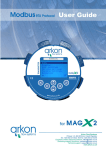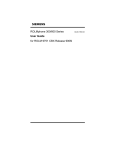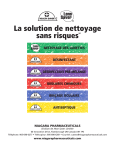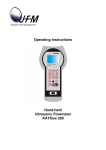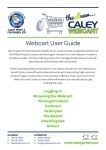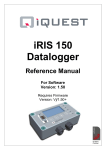Download MQU & MHU Modbus User Guide, ENG 23-03-2011
Transcript
List of Contents 1. INTRODUCTION................................................................................................................................... 3 1.1 Definitions and abbreviations............................................................................................................................ 3 1.2 References ......................................................................................................................................................... 3 2. TECHNICAL DATA .............................................................................................................................4 2.1 General Modbus RTU ....................................................................................................................................... 4 3. COMMISSIONING.................................................................................................................................5 4. Modbus ADDRESSING MODULE .......................................................................................................6 4.1 Modbus function code ....................................................................................................................................... 6 5. Modbus HOLDING REGISTERS .......................................................................................................7 6. Modbus RS485 MODULE FOR MQU 99 ............................................................................................9 7. CONTACT..............................................................................................................................................10 Modbus RTU Module User Guide 1 V1.3 29-04 -2011 Modbus RTU Module User Guide 2 V1.3 29-04 -2011 1. INTRODUCTION This manual describes the Modbus-RTU communication protocol. 1.1 Definitions and Abbreviations CRC Cyclic Redundancy Check, Used for error-checking in Modbus RTU. See appendix Modbus master A Modbus device, which is able to access data in one or more connected Modbus slaves Modbus slave A Modbus device, which is able to respond to requests from a single Modbus master Modbus address Throughout this document the following notation is used to address Modbus RTU registers: • 1234 - Holding register • 1234 (addressed in messages by 1233) RS 232 Refers to the communication standard defined by EIA/TIA-232C. (Physical layer) EIA/TIA232C USB Refers to the USB Specification usb.org RS 485 Refers to the 2-wire communication standard defined by EIA/TIA-485. (Physical layer) RTU Remote Terminal Unit – Standard Modbus transmission mode 1.2 References Reference 1 Modbus over Serial Line Specification & Implementation guide v. 1.0 Modbus.org 12/02/02 Reference 2 Modbus Application Protocol Specification v. 1.1 Modbus.org 12/06/02 Reference 3 MQU manual Modbus RTU Module User Guide 3 V1.3 29-04 -2011 2. TECHNICAL DATA Modbus RTU specification Device type Baud rates Recommended: Slave 4800, 9600, 14400, 19200, 38400, 56000, 57600, 115200 bits/sec. max. 31 per segment without repeaters 1-247 Modbus RTU (Other Modbus protocols like ASCII, Plus or TCP/IP are not supported) RS232, RS 485 - 2 wire, USB, Ethernet • 3 read holding registers • 16 write multiple registers No Reference 3 Device address range Number of stations Protocol Electrical interface Supported function code Broadcast Maximum cable length Standard Modbus over serial line v1.0) Certified No 2.1 General Modbus RTU The module complies with the Modbus serial line protocol [Reference 1]. Among other things, this implies a masterslave protocol at level 2 of the OSI model. One node, (the master), issues explicit commands to one of the „slave“-nodes and processes responses. Slave nodes will not transmit data without a request from the master node, and do not communicate with other slaves. Modbus is a mono master system, which means that only one master can be connected at any single point in time. Two modes of communication are possible, Unicast and Broadcast. Unicast mode is where the master sends a request to one slave device, and waits a specified time for a response. In Broadcast mode the master sends out a request to address „0“, which means that the information is for all slave devices on the network. In Broadcast mode there is no response from the slave devices. The Modbus frame is shown below, and is valid for both requests and responses. Slave address Function code Data CRC 1 Byte 1 Byte 0-252 Bytes 2 Bytes Further details of the Modbus protocol can be found in Reference 1 and 2. Modbus RTU Module User Guide 4 V1.3 29-04 -2011 3. COMMISSIONING Before communicating with the master, Baud rate, node ID and update rate must be selected. This can be done from the display. Please look in to the MQI, MQU transmitter manual to locate the Modbus RTU menu. (see Reference 3). Item Slave address Baud rate Parity/framing Response delay Interframe spacing Value 1-247 4800, 9600, 14400, 19200, 38400, 56000, 57600, 115200 Even, 1 stopbit Odd, 1 stopbit None, 2 stopbit None, 1 stopbit 0-255 msec. 3.5-25 chars Modbus RTU Module User Guide Comments Device address [Factory setting: 1] Communication speed [Factory setting: 9600] Communication parameters [Factory setting: Even, 1 stopbit] The minimum time from when a slave receives a request and until it returns a response. This makes it possible to send data to slow masters without overwhelming its receiver. [Factory setting: 0] The minimum interframe space between two Modbus RTU messages in sequence (specified as 3.5 characters) is configurable. Range: 3.5 - 25 character times. [Factory setting: 3,5] 5 V1.3 29-04 -2011 4. Modbus ADDRESSING MODULE The module allows R/W access to the following standard Modbus data register blocks: • Holding registers I.e. the module will not support the other standard data register blocks: • Coils • „Discrete input“ • „Input registers“ 4.1 Modbus function codes This device supports the following function codes: 3, 16 and 17. Function code 3 and 16 are used for accessing registers. Function code 17 (report slave ID) will return a structure of identification information of the device. Below the different function code exceptions are described. Function code 3 (Read holding registers) General exceptions: • Requesting less than 1 or more than 125 registers => Exception 3 (illegal data value) • Requesting more, than max. message size => Exception 2 (illegal data address) • Requesting data, above/crossing limitation of max. register address (0xFFFF) => Exception 2 (illegal data address) • If the end address is only part of a mapped holding register item (e.g. one half of a longint value)=> Exception 2 (Illegal data address) Application exceptions: • Application errors => Exception 2 (illegal data address) Holes/register alignment: • The read command always returns data if no exception is given. Bad start/end alignment will result in only parts of the data item being read. • Holes in the holding register map return Exception 2 (illegal data address) Function code 16 (Write multiple registers) General exceptions: • Exceeding max. message size => Exception 2 (illegal data address) • Writing data above/crossing limitation of max. register address (0xFFFF) => Exception 2 (illegal data address) Application exceptions: • Application errors => Exception 2 (illegal data address) • Application errors include writing to ReadOnly holding registers Holes / register alignment: • If start-address is not the start of a mapped holding register => Exception 2 (illegal data address) • Writing to holes is not allowed => Exception 2 (illegal data address) • If the end address is only part of a mapped holding register item (e.g. one half of a longint value), the action depends on the data type. • If the end address is only part of a mapped holding register item (e.g. one half of a longint value) => Exception 2 (illegal data address) Modbus RTU Module User Guide 6 V1.3 29-04 -2011 5. Modbus HOLDING REGISTERS In the following the holding registers for the MQU 99 Modbus RTU module are described. Modbus register Modbus address No. of bytes 1000 999 4 Float - - HA [m] R 1002 1001 4 Float - - HB [m] R 3 R 3 Data type Min Value Max Value Descriptio n Read/ Write 1004 1003 4 Float - - Qa [m /hr] 1006 1005 4 Float - - Qb [m /hr] R 1008 1007 4 Float - - Fail R 1010 1009 4 Float - - 3 R 3 Sa [m ] 1012 1011 4 Float - - Sb [m ] R 1014 1013 4 Float - - Ta [h] R 1016 1015 4 Float - - Tb [h] R 100 99 4 Long 4800 115200 102 101 4 Long 0 3 104 103 4 Long 1 247 106 105 4 Long 0 2 108 107 4 Long 0 70 110 109 4 Long 0 70 112 111 4 Long 0 255 Device info R/W 1 0 1 Bool 0 1 Relay 1 *** R 2 1 1 Bool 0 1 Relay 2 *** R 3 2 1 Bool 0 1 Relay 3 *** R 4 3 1 Bool 0 1 Relay 4 *** R Modbus Baud Rate * R/W Parity ** R/W Slave Address Protocol version Device RT Timeout [ms] Device RT Timeout reserve [ms] R/W R/W R/W R/W * 4800, 9600, 14400, 19200, 38400, 56000, 57600, 115200 If you write the wrong value to the Baudrate item, the default value 9600 will be written to this item. ** Parity values 0 None, 1 stopbit Modbus RTU Module User Guide 7 V1.3 29-04 -2011 When writing to the Holding registers, data validity is not checked. Writing incorrect values can result in unexpected behaviour of the device. In any further explanations, the following data types are used: • Longint – Number consisting of 32 bits, formed by 2 Modbus registers. It is necessary to write both Low and High Words of this item, the register number always has to be an even number. Not meeting these requirements will cause an Exception 2 error (illegal data address). In case information about the number of decimals is available, then the final number is given by the following formula: Y = X * 10^(- DEC), where Y is the final number, X the read number, and DEC the number of decimals. • Bool – this item can be read, but its value has no meaning. Writing value 1 to this item will cause an unspecified operation to be performed (erasing the Memory module, resetting the flow totalisers, etc. Reference 3). It is necessary to write both Low and High Words of this item, the register number always has to be an even number. Not meeting these requirements will cause an Exception 2 error (illegal data address). • Floating point – values are represented in standard IEEE format. Size of floating point value is 32 bits. Range represented number is from 1.18E-38 up to 3.39E+38. Sign bit (bit31), the most significant bit represents the sign of the number (0 for positive, 1 for negative). Exponent bits (bits 30 – 23), the next 8 bits represent the exponent. Mantissa bits (bits 22 – 0), the remaining 23 bits represent the mantissa. Data type memory map: Modbus register Data Type Low/High Word 2 Longint L 3 Longint H 4 Bool L 5 Bool H 6 Floating point L 7 Floating point H 8 Word -- Modbus RTU Module User Guide 8 V1.3 29-04 -2011 6. Modbus RS485 MODULE FOR MQU99 MQU99 communication modules and protocols (overview) MQU99 ultrasonic flowmeters can be equipped with the following communication modules * • RS232C module with company protocol ) • RS485 module with company protocol ) • Modbus RTU RS485 module with Modbus and company protocols ). Selection between these protocols is done by means of a module on-board jumper (Modbus – without jumper, company protocol – with jumper). * * * ) Note about company protocol versions: - MQU99 ultrasonic flowmeters have company protocol v.1, Using Modbus RTU RS485 module at Modbus RTU mode For this standard using Modbus RTU RS485 module, this module must be configured for Modbus protocol (without corresponding jumper). Furthermore, MQU99 or flowmeter with Modbus RTU RS485 module at Modbus RTU mode must have the following communication parameters (equal to factory settings): Device address: Baud rate: R/T timeout: 31 9600 Bd 10.0 ms These parameters are available by means of the flowmeter local keyboard and display (MAIN menu, RS 485 offer). • Modbus RTU RS485 module and SmartMQU software SmartMQU data acquisition software can communicate in ELA-1 protocol only. Therefore, while using this software with MQU99 flowmeter equipped by Modbus RTU RS485 module, this module must be configured for ELA protocol (with corresponding jumper). Modbus RTU Module User Guide 9 V1.3 29-04 -2011 7. CONTACT Technical support: [email protected] Windows life messenger: [email protected] Sales office: [email protected] Office hours: 8:30 – 18:00 (GMT+1) Direct technical support: 8:00 – 16:30 (GMT+1)) Modbus RTU Module User Guide 10 V1.3 29-04 -2011











